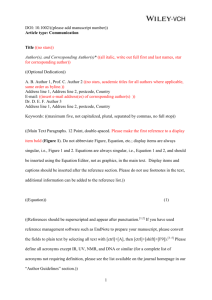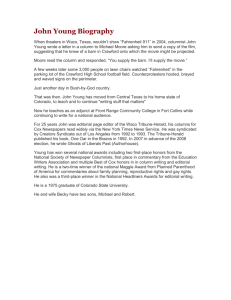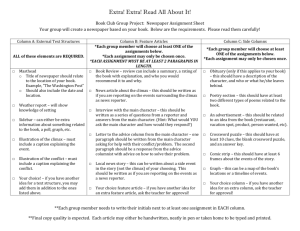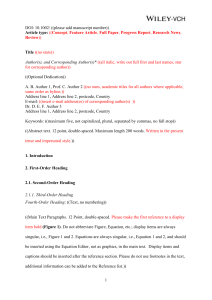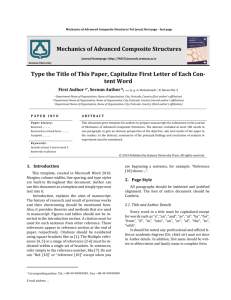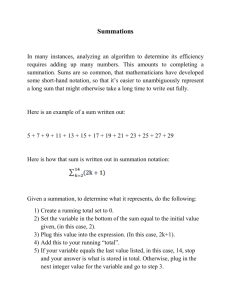Highlights - Wiley-VCH
advertisement
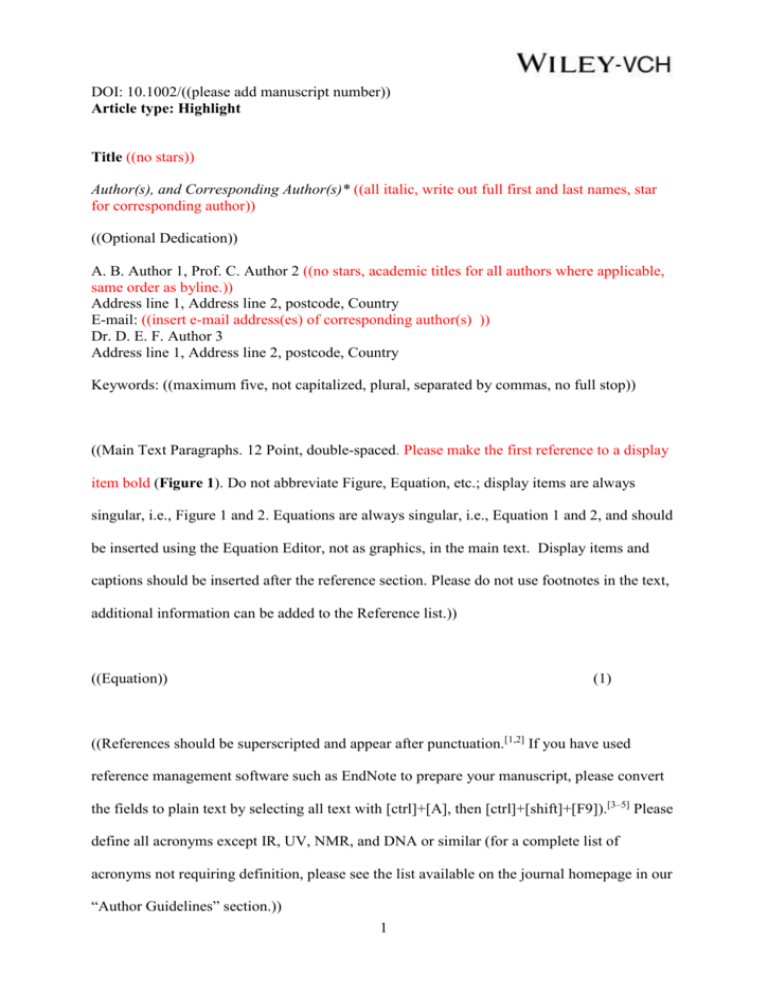
DOI: 10.1002/((please add manuscript number)) Article type: Highlight Title ((no stars)) Author(s), and Corresponding Author(s)* ((all italic, write out full first and last names, star for corresponding author)) ((Optional Dedication)) A. B. Author 1, Prof. C. Author 2 ((no stars, academic titles for all authors where applicable, same order as byline.)) Address line 1, Address line 2, postcode, Country E-mail: ((insert e-mail address(es) of corresponding author(s) )) Dr. D. E. F. Author 3 Address line 1, Address line 2, postcode, Country Keywords: ((maximum five, not capitalized, plural, separated by commas, no full stop)) ((Main Text Paragraphs. 12 Point, double-spaced. Please make the first reference to a display item bold (Figure 1). Do not abbreviate Figure, Equation, etc.; display items are always singular, i.e., Figure 1 and 2. Equations are always singular, i.e., Equation 1 and 2, and should be inserted using the Equation Editor, not as graphics, in the main text. Display items and captions should be inserted after the reference section. Please do not use footnotes in the text, additional information can be added to the Reference list.)) ((Equation)) (1) ((References should be superscripted and appear after punctuation.[1,2] If you have used reference management software such as EndNote to prepare your manuscript, please convert the fields to plain text by selecting all text with [ctrl]+[A], then [ctrl]+[shift]+[F9]).[3–5] Please define all acronyms except IR, UV, NMR, and DNA or similar (for a complete list of acronyms not requiring definition, please see the list available on the journal homepage in our “Author Guidelines” section.)) 1 Acknowledgements ((Acknowledgements, general annotations, funding. Other references to the title/authors can also appear here, such as “Author 1 and Author 2 contributed equally to this work.”)) Received: ((will be filled in by the editorial staff)) Revised: ((will be filled in by the editorial staff)) Published online: ((will be filled in by the editorial staff)) [1] ((Journal articles)) a) A. B. Author 1, C. D. Author 2, Adv. Mater. 2006, 18, 1; b) A. Author 1, B. Author 2, Adv. Funct. Mater. 2006, 16, 1. [2] ((Work accepted)) A. B. Author 1, C. D. Author 2, Macromol. Rapid Commun., DOI: 10.1002/marc.#########. [3] ((Books)) H. R. Allcock, Introduction to Materials Chemistry, Wiley, Hoboken, NJ, USA 2008. [4] ((Edited books or proceedings volumes)) J. W. Grate, G. C. Frye, in Sensors Update, Vol. 2 (Eds: H. Baltes, W. Göpel, J. Hesse), Wiley-VCH, Weinheim, Germany 1996, Ch. 2. [5] ((Presentation at a conference, proceeding not published)) Author, presented at Abbrev. Conf. Title, Location of Conference, Date of Conference ((Month, Year)). [6] ((Thesis)) Author, Degree Thesis, University (location if not obvious), Month, Year. [7] ((Patents)) a) A. B. Author 1, C. D. Author 2 (Company), Country Patent Number, Year; b) W. Lehmann, H. Rinke (Bayer AG) Ger. 838217, 1952. [8] ((Website)) Author, Short description or title, URL, accessed: Month, Year. [9] …((Please include all authors, and do not use “et al.”)) ((Insert Figure here. Note: Please do not combine figure and caption in a textbox or frame.)) Figure 1. ((Figure Caption.)) Reproduced with permission.[Ref.] Copyright Year, Publisher. ((delete if not applicable)) 2 Table 1. ((Table Caption. Note: Please do not combine table and caption in a textbox or frame and do not submit tables as graphics, please use Word’s “insert table” function.)) Head 1 [units]a) Head 2 Head 3 Head 4 Head 5 [units] Column 1 Column 2 Column 3b) Column 4 Column 5 Column 1 Column 2 Column 3 Column 4 Column 5 a) ((Table Footnote)); b) … 3 The table of contents entry should be 50−60 words long, and the first phrase should be bold. The entry should be written in the present tense and impersonal style. Keyword C. Author 2, D. E. F. Author 3, A. B. Corresponding Author* ((same order as byline)) Title ((no stars)) ToC figure ((Please choose one size: 55 mm broad × 50 mm high or 110 mm broad × 20 mm high. Please do not use any other dimensions)) 4
